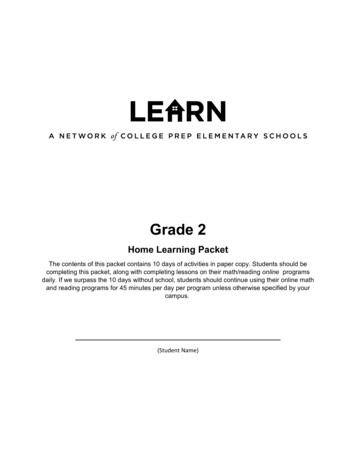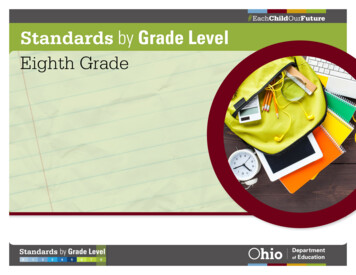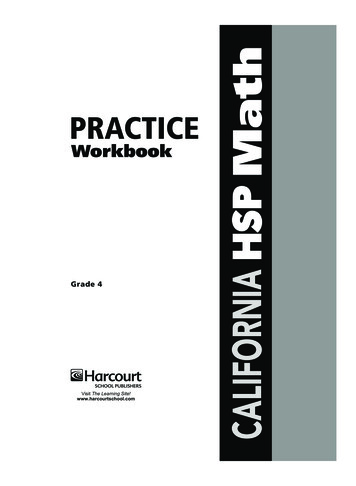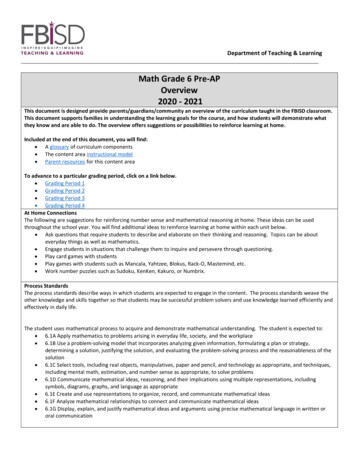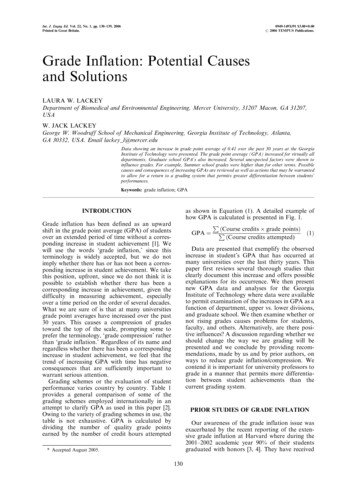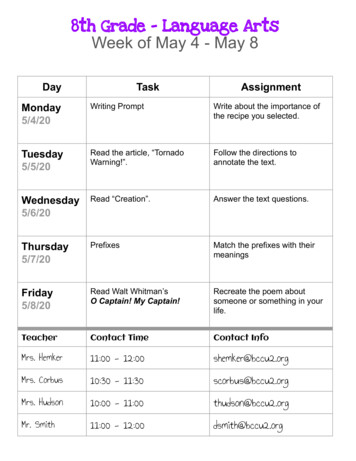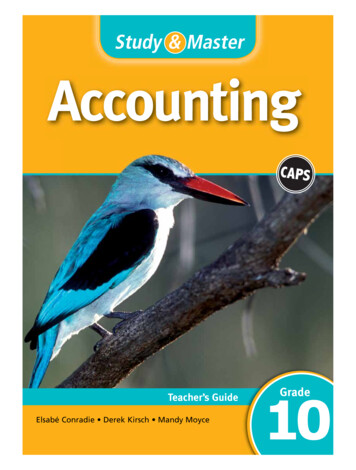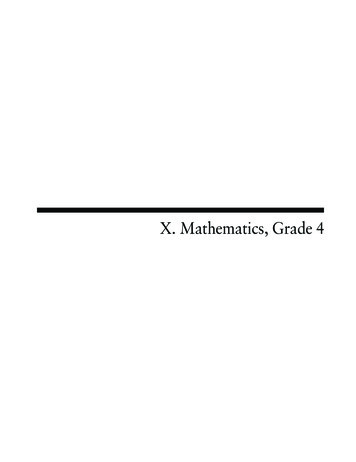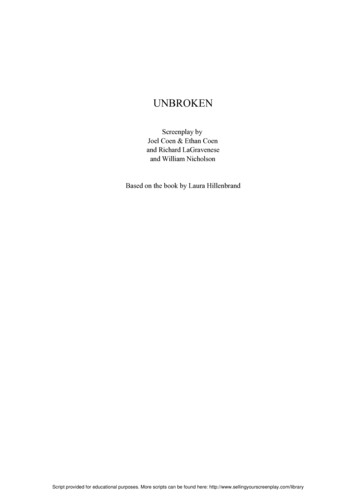
Transcription
Grade 8: Module 3A:OverviewThis work is licensed under a Creative Commons Attribution-NonCommercial-ShareAlike 3.0 Unported License.Exempt third-party content is indicated by the footer: (name of copyright holder). Used by permission and not subject to Creative Commons license.
GRADE 8: MODULE 3A: OVERVIEWJapanese-American Relations during World War IIIn this module, students will study Japanese-American relations during WorldWar II. They will consider the question “How does war affect individuals andsocieties?” as they read case studies about the plight of Japanese-Americansinterned on American soil and American prisoners of war held captive in Japanduring World War II. The central texts are Unbroken by Laura Hillenbrand and ashort biography of Miné Okubo, a Japanese-American interned during the war. Asstudents read both of these pieces of literary nonfiction, they will consider how thenarrative structure can communicate real events in a compelling manner. In Unit 1,students will build background knowledge as they consider the causes of Japaneseand American involvement in World War II focusing on the war in the Pacific. Theywill begin by studying the attack on Pearl Harbor, considering conflicting accountsof this pivotal event.In Unit 2, students will analyze case studies of Louie Zamperini (in Unbroken)and Miné Okubo to explore the thematic concept of resisting “invisibility” whilebeing held captive. Students also will read primary source documents related to theinternment of Japanese-Americans during World War II. Finally, in Unit 3,students will finish reading Unbroken and study a second thematic concept: thejourney of the imprisoned or interned to becoming “visible” after release. Studentswill research Miné Okubo’s life after internment; and for their final performancetask, the will write a narrative in which they tell the story of how she went frombeing made “invisible” during internment to becoming “visible” post-internment.This module is content-rich; consider previewing the full module with a socialstudies colleague and finding ways to collaborate to provide an even richerexperience.Guiding Questions And Big Ideas How does war and conflict affect individuals and societies? How do historians/readers reconcile multiple accounts of the same event? How can narrative be used to communicate real events? How does captivity make the captive invisible? How can individuals become visible again? What are the advantages and disadvantages of using different media? The war affected both ordinary Japanese-Americans and American prisoners of war in life-changing ways. War and conflict bring important yet divergent experiences to individuals and societies. There are important yet divergent experiences in war and conflict.Created by Expeditionary Learning, on behalf of Public Consulting Group, Inc. Public Consulting Group, Inc., with a perpetual license granted to ExpeditionaryLearning Outward Bound, Inc.NYS Common Core ELA Curriculum G8:M3A: Overview November 2013 1
GRADE 8: MODULE 3A: OVERVIEWJapanese-American Relations during World War IIPerformance TaskStudents will research Miné Okubo’s life after internment; and for their final performance task, they will share and reflect on their narrative in which they tell the story ofhow Okubo went from resisting efforts to make her “invisible” during internment to becoming “visible” post-internment. Students will base their exploded momentnarrative on the following writing prompt: “Writing from Miné Okubo’s perspective, tell the story of one moment in her struggle to become visible after leaving theinternment camp. Use narrative techniques and incorporate information from sources about Okubo’s life to write an original narrative to answer the question ‘How didOkubo become visible after her life in the internment camp?’ The narrative must end with the sentence “I was visible again.” This performance task centers onNYSP12 ELA CCLS W.8.3, W.8.6, W.8.9b, L.8.1, L.8.1b, L.8.1c, L.8.2, L.8.2c, and L.8.3.Content ConnectionsNYS Social Studies Core Curriculum:3. Time, Continuity, and Change Reading, reconstructing, and interpreting events Analyzing causes and consequences of events and developments Considering competing interpretations of events6. Power, Authority and Governance Origins, uses, and abuses of power Conflict, diplomacy, and war10. Global Connections and Exchange Past, current, and likely future global connections and interactions Cultural diffusion, the spread of ideas, beliefs, technology, and goods Benefits/consequences of global interdependence (social, political, economic) Tension between national interests and global prioritiesCreated by Expeditionary Learning, on behalf of Public Consulting Group, Inc. Public Consulting Group, Inc., with a perpetual license granted to ExpeditionaryLearning Outward Bound, Inc.NYS Common Core ELA Curriculum G8:M3A: Overview November 2013 2
GRADE 8: MODULE 3A: OVERVIEWEnglish Language Arts OutcomesCCS Standards: Reading—Literature1Long-Term Learning Targets RL.8.3 . Analyze how particular lines of dialogue or incidents in a story ordrama propel the action, reveal aspects of a character, or provoke a decision. I can analyze how specific dialogue or incidents in a plot propel the action,reveal aspects of a character, or provoke a decision.CCS Standards: Informational TextLong-Term Learning Targets RI.8.1. Cite the textual evidence that most strongly supports an analysis of whatthe text says explicitly as well as inferences drawn from the text. I can cite text-based evidence that provides the strongest support for an analysisof literary text. RI.8.2. Determine a central idea of a text and analyze its development over thecourse of the text, including its relationship to supporting ideas; provide anobjective summary of the text. I can determine a theme or the central ideas of an informational text. I can analyze the development of a theme or central idea throughout the text(including its relationship to supporting ideas). I can objectively summarize informational text. RI.8.3. Analyze how a text makes connections among and distinctions betweenindividuals, ideas, or events (e.g., through comparisons, analogies, orcategories). I can analyze the connections and distinctions between individuals, ideas orevents in a text. RI.8.4. Determine the meaning of words and phrases as they are used in a text,including figurative, connotative, and technical meanings; analyze the impact ofspecific word choices on meaning and tone, including analogies or allusions toother texts. I can determine the meaning of words and phrases in text (figurative,connotative, and technical meanings). I can analyze the impact of word choice on meaning and tone (analogies orallusions).Laura Hillenbrand presents the compelling story of Louis Zamperini in the literary nonfiction book, Unbroken: A World War II Story of Survival, Resilience, andRedemption. To be clear, this central text is nonfiction, and many aspects of the text will be analyzed using the Reading Standards for Information Text. However, since thebook is also a narrative, the Reading Standards for Literature are, at times, also a useful lens. For example, Louie Zamperini is the main character that is developed over thecourse of the text. He happens to be a real character; nevertheless, studying his development using the Reading Literature Standard RL.8.3 is helpful. More detailsregarding this are provided in relevant lessons.1Created by Expeditionary Learning, on behalf of Public Consulting Group, Inc. Public Consulting Group, Inc., with a perpetual license granted to ExpeditionaryLearning Outward Bound, Inc.NYS Common Core ELA Curriculum G8:M3A: Overview November 2013 3
GRADE 8: MODULE 3A: OVERVIEWEnglish Language Arts OutcomesCCS Standards: Informational TextLong-Term Learning Targets RI.8.6. Determine an author’s point of view or purpose in a text and analyzehow the author acknowledges and responds to conflicting evidence orviewpoints. I can determine an author’s point of view or purpose in informational text. I can analyze how the author acknowledges and responds to conflicting evidenceor viewpoints. RI.8.7. Evaluate the advantages and disadvantages of using different media(e.g., print or digital text, video, multimedia) to present a particular topic oridea. I can evaluate the advantages and disadvantages of using different media topresent an idea. RI.8.9. Analyze a case in which two or more texts provide conflictinginformation on the same topic and identify where the texts disagree on mattersof fact or interpretation. I can analyze texts for disagreement on facts or interpretation. RI.8.10. By the end of the year, read and comprehend literary nonfiction at thehigh end of the grades 6–8 text complexity band independently and proficiently. I can read grade-level informational texts proficiently and independently.Created by Expeditionary Learning, on behalf of Public Consulting Group, Inc. Public Consulting Group, Inc., with a perpetual license granted to ExpeditionaryLearning Outward Bound, Inc. I can read above-grade informational texts with scaffolding and support.NYS Common Core ELA Curriculum G8:M3A: Overview November 2013 4
GRADE 8: MODULE 3A: OVERVIEWEnglish Language Arts OutcomesCCS Standards: WritingLong-Term Learning Targets W.8.2. Write informative/explanatory texts to examine a topic and convey ideas,concepts, and information through the selection, organization, and analysis ofrelevant content. I can write informative/explanatory texts that convey ideas and concepts usingrelevant information that is carefully selected and organized.a. Introduce a topic clearly, previewing what is to follow; organize ideas,concepts, and information into broader categories; include formatting (e.g.,headings), graphics (e.g., charts, tables), and multimedia when useful toaiding comprehension.b. Develop the topic with relevant, well-chosen facts, definitions, concretedetails, quotations, or other information and examples.c. Use appropriate and varied transitions to create cohesion and clarify therelationships among ideas and concepts.d. Use precise language and domain-specific vocabulary to inform about orexplain the topic.e. Establish and maintain a formal style.f. Provide a concluding statement or section that follows from and supportsthe information or explanation presented.Created by Expeditionary Learning, on behalf of Public Consulting Group, Inc. Public Consulting Group, Inc., with a perpetual license granted to ExpeditionaryLearning Outward Bound, Inc.NYS Common Core ELA Curriculum G8:M3A: Overview November 2013 5
GRADE 8: MODULE 3A: OVERVIEWEnglish Language Arts OutcomesCCS Standards: WritingLong-Term Learning Targets W.8.3. Write narratives to develop real or imagined experiences or events usingeffective technique, relevant descriptive details, and well-structured eventsequences. I can write narrative texts about real or imagined experiences using relevantdetails and event sequences that make sense.a. Engage and orient the reader by establishing a context and point of viewand introducing a narrator and/or characters; organize an event sequencethat unfolds naturally and logically.b. Use narrative techniques, such as dialogue, pacing, description, andreflection, to develop experiences, events, and/or characters.c. Use a variety of transition words, phrases, and clauses to convey sequence,signal shifts from one time frame or setting to another, and show therelationships among experiences and events.d. Use precise words and phrases, relevant descriptive details, and sensorylanguage to capture the action and convey experiences and events.e. Provide a conclusion that follows from and reflects on the narratedexperiences or events. W.8.9. Draw evidence from literary or informational texts to support analysis,reflection, and research. I can use evidence from informational texts to support analysis, reflection, andresearch.a. Apply grade 8 Reading standards to literature (e.g., “Analyze how a modernwork of fiction draws on themes, patterns of events, or character types frommyths, traditional stories, or religious works such as the Bible, includingdescribing how the material is rendered new”).b. Apply grade 8 Reading standards to literary nonfiction (e.g., “Delineate andevaluate the argument and specific claims in a text, assessing whether thereasoning is sound and the evidence is relevant and sufficient; recognizewhen irrelevant evidence is introduced”).Created by Expeditionary Learning, on behalf of Public Consulting Group, Inc. Public Consulting Group, Inc., with a perpetual license granted to ExpeditionaryLearning Outward Bound, Inc.NYS Common Core ELA Curriculum G8:M3A: Overview November 2013 6
GRADE 8: MODULE 3A: OVERVIEWEnglish Language Arts OutcomesCCS Standards: WritingLong-Term Learning Targets W.8.11a Create a presentation, artwork, or text in response to a literary work,with a commentary that identifies and explains divergences from the original. I can support the personal, cultural, textual, and thematic connections I makeacross genres.a. Make well-supported personal, cultural, textual, and thematic connectionsacross genres. (W.8.11a)b. Create poetry, stories, plays, and other literary forms (e.g. videos, art workCCS Standards: Speaking & ListeningLong-Term Learning Targets SL.8.1. Engage effectively in a range of collaborative discussions (one-on-one, ingroups, and teacher-led) with diverse partners on grade 8 topics, texts, andissues, building on others’ ideas and expressing their own clearly. I can effectively engage in discussions with diverse partners about eighth-gradetopics, texts, and issues.a. Come to discussions prepared, having read or researched material understudy; explicitly draw on that preparation by referring to evidence on thetopic, text, or issue to probe and reflect on ideas under dis
1 Laura Hillenbrand presents the compelling story of Louis Zamperini in the literary nonfiction book, Unbroken: A World War II Story of Survival, Resilience, and Redemption. To be clear, this central text is nonfiction, and many aspects of the text will be analyzed using the Reading Standards for Information Text. However, since the book is also a narrative, the Reading Standards for .
